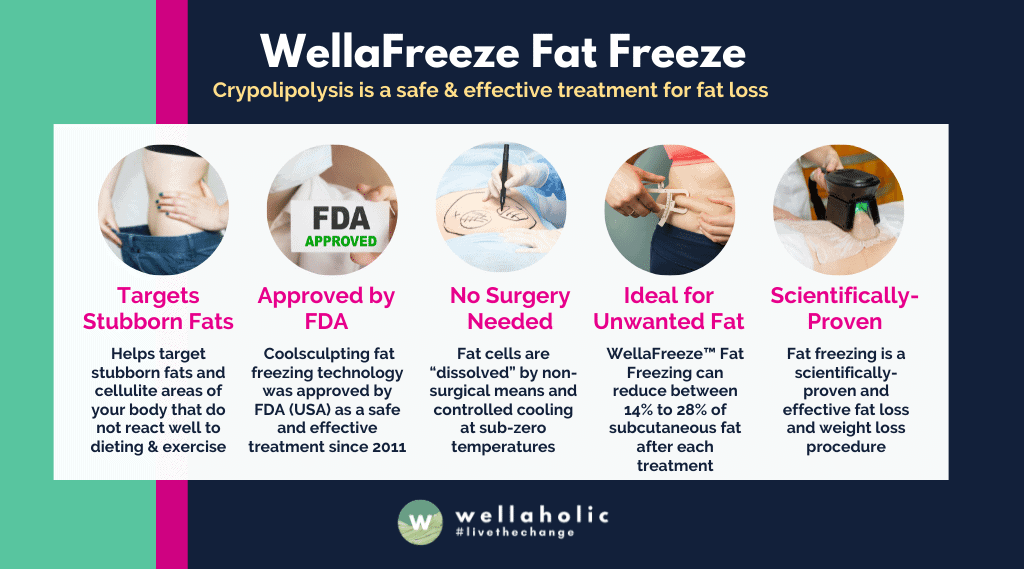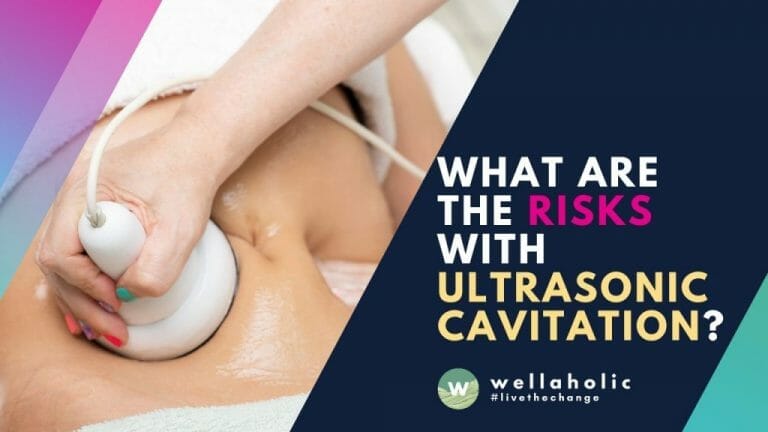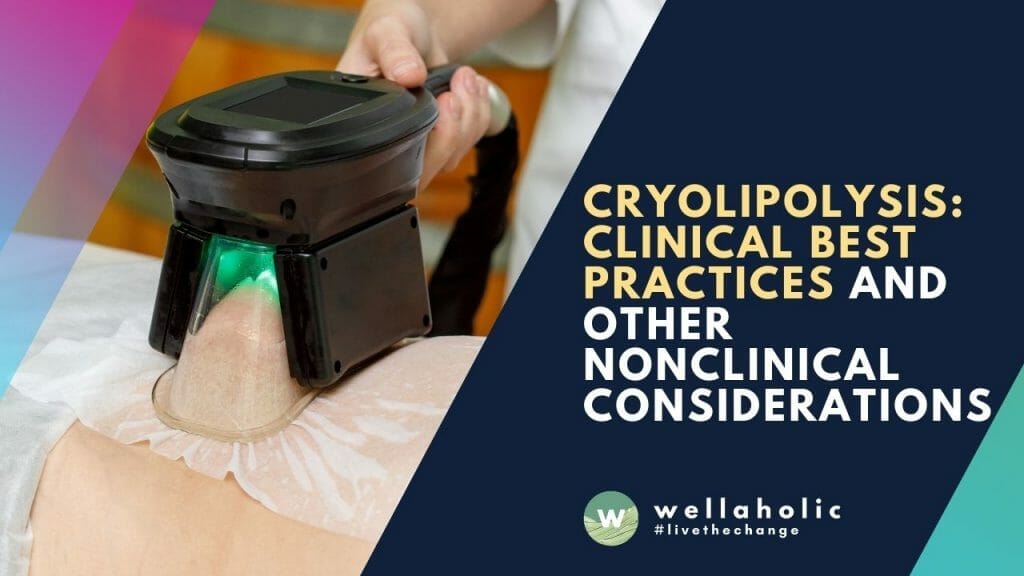
Wellaholic Research: Cryolipolysis: Clinical Best Practices and Other Nonclinical Considerations
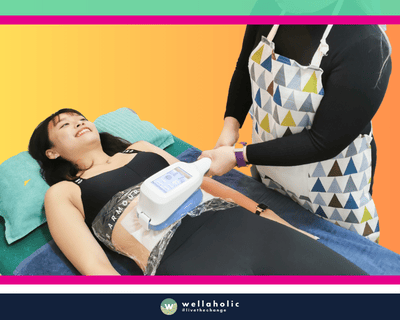
Table of Contents
- 0.1 Background
- 0.2 Introduction
- 0.3 Who Is a Good Candidate for Cryolipolysis?
- 0.4 Patient Consultation
- 0.5 Procedural Considerations
- 0.6 Cryolipolysis as a Tool to Engage New Patients and Expand Service Offerings for Current Patients
- 0.7 Conclusion
- 0.8 Source
- 0.9 Book Now Pay Later
- 0.10 WellaFreeze™ 360 Advanced Fat Freezing
- 1 Wellaholic Research: Unveiling Clinical Best Practices and Nonclinical Considerations of Cryolipolysis in Singapore
Background
Cryolipolysis is a nonsurgical body contouring procedure that involves cooling of fat cells to induce lipolysis while sparing surrounding structures. Plastic surgery practices are increasingly incorporating noninvasive aesthetic procedures (eg, cryolipolysis, fillers, radiofrequency, ultrasound) to offer their patients a wider range of aesthetic treatment options.
Here, we report insights from 8 plastic surgeons with regard to cryolipolysis best practices from a clinical perspective and the impact of integrating this noninvasive body contouring procedure into a plastic surgery practice.
Setting Realistic Expectations for Cryolipolysis Outcomes
The authors prefer cryolipolysis over liposuction for patients who are not amenable to surgery or those who desire to avoid downtime, also taking into consideration body mass index, skin laxity, comorbidities, and risk of contour irregularities.
Patient counseling is critical for setting realistic expectations regarding outcomes and should focus on the efficacy of cryolipolysis, individual variability in results, potential side effects, time course of treatment response, and the need for multiple treatment cycles. Strategies for reaching new patients and expanding services among current cryolipolysis patients are discussed.

Introduction
Cryolipolysis is a well-established nonsurgical body contouring procedure that involves controlled, localized cooling of subcutaneous adipocytes to induce apoptosis without damage to other tissue.1,2 The adipocytes are subsequently engulfed and digested by macrophages and then cleared by natural inflammatory processes over the next 3 months.1,2 This procedure selectively targets subcutaneous fat using natural thermal diffusion while sparing overlying skin and surrounding structures and causes only modest, transient changes in nerve function.1-3
CoolSculpting: FDA Cleared for Multiple Body Areas
CoolSculpting (ZELTIQ Aesthetics, Inc., Pleasanton, CA, USA) was initially cleared as a class II cryolipolysis device by the US Food and Drug Administration (FDA) in 2010 for fat reduction in the flanks4 and has subsequently been cleared to treat fat bulges in the abdomen (2012),5 the thigh (2014),6 the submental area (2015),7 and the upper arm (2016),8 as well as back/“bra” fat (2016),9 and fat underneath the buttocks (ie, “banana roll”; 2016).9 More recently (2017), CoolSculpting was FDA cleared for improvement in the appearance of lax tissue in conjunction with submental area treatments.10
In 2018, CoolSculpting received FDA clearance for the treatment of the submandibular area.11 CoolSculpting is cleared for individuals with body mass index ≤46.2 kg/m2 in the submental and submandibular areas and for those with body mass index ≤30 kg/m2 for all other body areas.11
The Rise of Noninvasive Aesthetics in Plastic Surgery Practices
Noninvasive aesthetic procedures, such as cryolipolysis, are increasingly being incorporated into plastic surgery practices as surgeons aim to offer patients a wider range of aesthetic treatment options.12 In a survey conducted jointly by the American Society of Plastic Surgeons (ASPS) and The Aesthetic Society in 2007,13 97% of plastic surgeons reported that they added noninvasive procedures to their practice in order to provide patients with a continuum of care, and more than 80% offered noninvasive procedures to ensure that patients had access to the most up-to-date techniques, to better compete as full-service providers, and to identify patients who may be subsequently interested in plastic surgery.12
Nonsurgical fat reduction was the third most common nonsurgical procedure performed in 2017 by members of The Aesthetic Society.13 Members reported nearly 181,000 noninvasive fat-reducing procedures in 2017, representing an increase of approximately 25% since 2016 and a more than 2-fold increase compared with 2012.13
Expert Insights on Cryolipolysis Best Practices
Demand for noninvasive aesthetic procedures, such as cryolipolysis, is expected to grow over the next several decades. According to the 2018 American Society for Dermatologic Surgery consumer survey on cosmetic dermatology procedures, nearly 7 in 10 respondents indicated that they are considering a cosmetic procedure.14 Overall, 86% of respondents were bothered by excess weight on any part of their body.14 Consistent with this observation, body sculpting was endorsed by 57% of survey respondents as the top procedure.14
A group of 8 plastic surgeons from across the United States with extensive experience using cryolipolysis (authors J.F., R.S., M.B., M.K., K.M., K.A.M., D.S., and A.J.B.) convened in March 2018 to collect insights regarding clinical best practices when using this procedure and to provide a greater understanding of the impact of integrating cryolipolysis into the plastic surgery practice. Here, we report their insights within the context of the clinical literature.
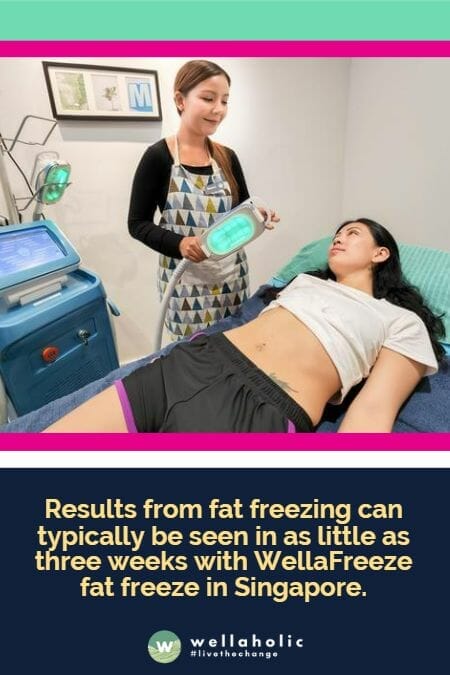
Who Is a Good Candidate for Cryolipolysis?
A thorough medical history and physical examination are important components of patient assessment.15 The medical history should include rheumatologic history, surgical history, and current medication use. The physical examination should ensure that areas of focal adiposity can be easily lifted from the underlying musculature and should evaluate for hernia, both while the patient is recumbent and during the performance of a Valsalva maneuver, because the vacuum suctioning can potentially incarcerate a hernia.15 This time can be used as an opportunity to talk about the cryolipolysis process, which may require multiple sessions to produce a gradual reduction in fat.
Unlike liposuction, cryolipolysis produces a modest and gradual reduction in subcutaneous fat,1 and multiple treatment cycles and sessions may be needed depending on the treatment area, individual characteristics, and patient goals.16 For these reasons, the authors prefer liposuction over cryolipolysis for patients who require significant debulking or who have a desire for immediate results. Liposuction is also preferred when the treatment plan includes the transfer of fat to augment other body areas, such as the buttocks, face, or breast.
Good candidates for cryolipolysis include nonobese patients (body mass index <30 kg/m2) seeking contouring or localized reduction of fat pockets, as opposed to significant debulking (Table 1).17 However, cryolipolysis should not be considered if the fat layer is insufficient, as this may unfavorably impact the placement of the vacuum applicator in the treatment area.15,17 Patients with accompanying mild-to-moderate skin laxity may be considered for cryolipolysis, but in patients with substantial skin laxity, the authors also recommend a skin tightening treatment.17 The authors favor cryolipolysis over liposuction for those individuals with comorbidities that would make them poor candidates for liposuction (eg, patients who are unfit to tolerate or are unwilling to undergo anesthesia), although it should not be assumed that a patient who is not a candidate for surgery because of comorbidities is necessarily a good candidate for cryolipolysis because factors such as obesity still need to be considered.18 The authors opine that cryolipolysis is preferred when patients seek treatment of body areas such as the banana roll, distal thigh/knee, and back/bra area that, because of the dermal to fascial relationship, are associated with a risk of contour irregularities with liposuction.
Figure 1 depicts an ideal candidate for cryolipolysis of the submental region. Cryolipolysis was chosen instead of liposuction for this patient because she was seeking localized reduction of fat rather than significant debulking, and did not want the risk of loose skin and contour irregularities. She was not obese, and the fat layer was sufficient for attachment of the applicator. In the opinion of the author who treated her (K.M.), the outcome observed in this patient, characterized by a reduction in submental fat resulting in a natural-appearing submental contour with improved skin laxity, would not have been achieved with liposuction. The results in this patient are consistent with those reported in a clinical trial of submental cryolipolysis in 14 patients, in whom reduction in fat volume, fat thickness, and skin surface area were observed after 2 treatments.19
Patient preferences should also be considered during patient assessment. Those individuals who are not amenable to surgery may be open to a noninvasive procedure such as cryolipolysis as an alternative. In one author’s experience (A.J.B.), approximately 30% of the patients in his plastic surgery practice state that they would not choose a surgical solution, while in other practice settings (eg, dermatology) this figure may approach 90%. Patients who express a desire to avoid downtime may also be good candidates for cryolipolysis. Notably, cryolipolysis is not associated with any significant downtime, whereas patients undergoing liposuction may need to take time off from work for recovery.13
Cryolipolysis is contraindicated in patients with cryoglobulinemia, paroxysmal cold hemoglobinuria, and cold agglutinin disease,20 and should be considered with caution in patients with cold-sensitive disorders, including Raynaud’s phenomenon and cold urticaria, or known neurologic disease.15
Cryolipolysis may also be combined with other procedures to achieve desired patient outcomes. In a patient who initially wanted to avoid surgery, one author (K.M.) used cryolipolysis on the flanks/lower back and abdomen, achieving patient satisfaction with the flanks/lower back after 2 treatments (Figure 2). Spurred by the treatment success in the flanks/lower back, the patient decided to undergo abdominoplasty to further improve the appearance of the abdomen.
In order to further optimize patient outcomes, the authors occasionally use cryolipolysis following surgical procedures, such as augmentation/reduction/mastopexy, abdominoplasty, or liposuction. For example, because aggressive liposuction of the undermined lower abdominal skin at the time of abdominoplasty is contraindicated owing to concerns regarding vascularity, it may be advantageous in some patients to follow abdominoplasty with cryolipolysis to address remaining lipodystrophy. The authors recommend waiting approximately 9 to 10 months after abdominoplasty in such cases so that any lymphedema resolves before cryolipolysis is considered. The authors also use cryolipolysis in combination with other noninvasive body treatment options, such as Cellfina on thighs/buttocks to treat cellulite and radiofrequency therapy to tighten skin.21,22

Patient Consultation
Patient counseling is critical for setting realistic expectations regarding outcomes and is an important predictor of patient satisfaction.15 Patient-focused visual aids, such as a 3-dimensional model of a cross section of a fat layer, can be helpful for explaining how cryolipolysis works and for setting expectations around anticipated results and the possible need for additional treatments. Prospective patients should understand that the results of cryolipolysis are not as immediate or dramatic as with liposuction.15 In addition, patients should be informed that cryolipolysis is not a weight loss procedure or a substitute for healthy diet and exercise.15,17 When discussing treatment of the abdominal bulge with any fat reduction procedure, one author (K.M.) emphasizes 2 important factors with his patients. First, any such procedure will only address extra-abdominal fat and will not affect intra-abdominal fat, highlighting the importance of weight loss in reducing the abdominal bulge. Second, diastasis of recti muscles can contribute significantly to the abdominal bulge and will not be addressed by fat reduction procedures.
The effectiveness of cryolipolysis treatment of the flanks,20 abdomen,20 inner thigh,23 outer thigh,24 submental area,25 and upper arm26 in healthy adult volunteers was evaluated in clinical studies, the results of which are presented in Table 2. Patients in these studies were required to maintain a stable weight in order to avoid confounding the effects of weight loss or gain on efficacy measures.23-26 Patient satisfaction was evaluated using patient-reported outcome questionnaires.20,23,25 For each study, 2 or 3 blinded, independent physicians reviewed pretreatment and posttreatment patient photographs, presented to them in random order.20,23-26 Independent photograph review of pre- and posttreatment patient photographs by 2 to 3 blinded physicians was used as the primary efficacy measure in these studies.20,23-26 Efficacy was also assessed quantitatively through ultrasound imaging, with results expressed as mean reduction in fat layer (stated as mm and/or percentage change from baseline).20,23-26
Patients in these clinical studies20,23-26 expressed high levels of satisfaction with cryolipolysis (Table 2). The authors recommend communicating the satisfaction levels of other patients in the practice along with the results of their cryolipolysis during prospective patient consultations. As shown in Table 2, outcomes following cryolipolysis can vary depending on body treatment area. When describing the efficacy of cryolipolysis to patients, the authors recommend that, for consistency with published data, outcomes be expressed in terms of average percentage reduction vs millimeter decrease in fat. A retrospective study of 518 patients who received cryolipolysis of the flanks, abdomen, back, inner thighs and knees, or buttocks at 2 European sites reported a 23% average reduction in fat thickness.27 Among these 518 patients, 891 body areas were treated; most treatment areas (86.5%) had 1 cryolipolysis treatment. These results are consistent with those reported in a systematic review of 19 studies, including prospective studies, retrospective studies, and case reports, which summarized reduction in fat in various treatment areas.28 The studies included in the systematic review reported caliper measurements that demonstrated 15% to 27% fat reduction in the abdomen (3 studies; patient number range, 14–55), 20% in the bra area (1 study; N = 4 patients), 22% in the lumbar area (1 study; N = 2 patients), 15% to 25% in the flanks (4 studies; patient number range, 1–20), 17% to 20% in the inner thigh (3 studies; patient number range, 3–18), 18% in the medial knee (1 study; N = 1), and 20% to 29% in the hip/outer thigh area (1 study; N = 16 [n = 8 with 1 treatment; n = 8 with 2 treatments]). In addition, imaging measurements reported 10% to 15% fat reduction in the abdomen (1 study; N = 17) and 22% to 26% in the flanks (3 studies; patient number range, 9–32).
Prospective patients should be informed that there may be inter-individual variability in results. It is also important to explain the time course for optimal results, as the patients may not observe a visible difference until up to 3 months after cryolipolysis and in some cases may require multiple treatment sessions to achieve the desired outcomes. Patients should be informed that liposuction remains an option if results of cryolipolysis do not meet their goals.
The patient consultation should also include education about potential treatment-emergent adverse events (AEs), although these are infrequent and usually transient. More common treatment-emergent AEs associated with cryolipolysis include erythema, bruising, swelling, sensitivity, and pain, and typically resolve within a few weeks.28 A systematic review of 16 references (N = 1445 patients), including studies as well as case reports/series, found that 0.8% of patients experienced AEs, with the most common one being decreased sensation in the treatment area lasting greater than 4 weeks.29 Paradoxical adipose hyperplasia (PAH) is an infrequent complication associated with cryolipolysis and occurs in approximately 1 in 4000 treatment cycles.30,31 This complication has been reported in association with treatment of the abdomen, flanks, back, thighs, and chest and tends to occur within a few months after cryolipolysis.31,32 Based on literature reports, men and people of Hispanic/Latino ethnicity are considered to be at a greater risk of developing PAH.30,33 It is important to inform patients of this potential side effect and to monitor patients for PAH for at least 6 months after cryolipolysis.32 If it develops, PAH can often be effectively treated with liposuction,34,35 but in one author’s experience (M.K.), abdominoplasty may be necessary if the patient has a large panniculus or if there is excessive loose skin.
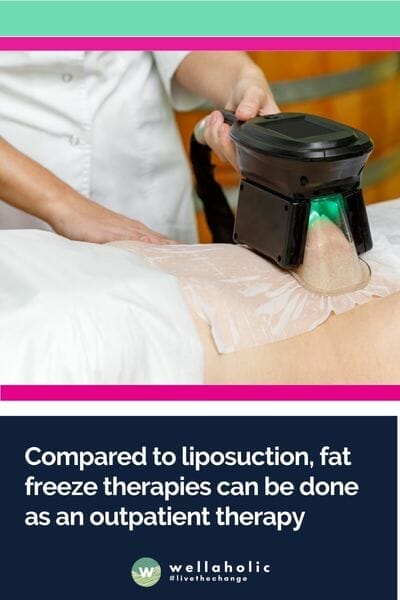
Procedural Considerations
More than 1 cryolipolysis treatment cycle or session may be needed to achieve the outcome desired by the patient. The first treatment session targets approximately the first centimeter of fat,2 and subsequent treatments target deeper layers of fat. The number of cycles per session should be individualized based on the patient’s treatment goals and body size. Larger patients with more subcutaneous fat will likely require more treatment cycles and sessions than thinner patients. Similarly, patients striving for complete correction usually require multiple cycles. Clinicians should wait a sufficient amount of time after each treatment session to adequately assess the results and base their recommendation for subsequent treatment sessions on the patient’s goals.
In a retrospective review of 528 consecutive patients from a single practice who underwent cryolipolysis between 2010 and 2012, Stevens et al16 reported that they typically recommend 2 treatment cycles (60 minutes each in duration) spaced 8 weeks apart for each treatment area. In their practice, the average number of treatment cycles differed by body area, ranging from 1.06 for the flanks to 2.26 for the back.16
Applicators are selected based on the patient’s treatment goals and the size and location of the treatment area. If available, multiple applicators can be applied at the same time to treat multiple areas.16 For example, if the practice has access to 2 devices, then left and right flanks can be treated simultaneously to reduce the required total treatment time. Figure 3 shows a patient in whom cryolipolysis with 3 applicators placed on the abdomen during the same treatment resulted in achievement of treatment goals in a single session.
Evolving technology has led to the development of newer applicators that reduce treatment time from 60 to 35 minutes and may be more comfortable for patients. A recent study showed that a prototype CoolCup medium-sized vacuum applicator (CoolSculpting System; Allergan plc, Dublin, Ireland), which has since evolved to the commercially available CoolAdvantage applicator, was as effective as a standard applicator but reduced the time required for cryolipolysis of the flank by 42%.36 The prototype CoolCup applicator was also associated with lower pain scores and less bruising than the standard applicator.36 Furthermore, owing to the reduced treatment time and improved comfort, 85% of patients preferred the prototype CoolCup applicator.36
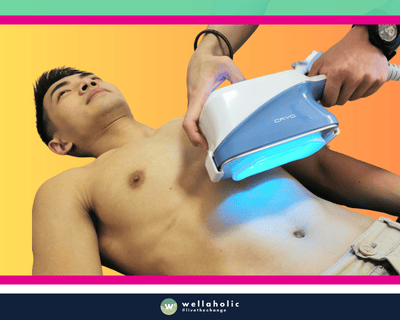
Cryolipolysis as a Tool to Engage New Patients and Expand Service Offerings for Current Patients
Reaching New Patients
The authors reported that digital efforts, including social media and retargeting advertisements, have allowed them to achieve their greatest success in reaching new patients. They place less focus on traditional advertising methods, such as television, radio, print, and billboards, although advertising in airline magazines continues to be fruitful. Practice-sponsored events that primarily target “VIP” patients have also been successful.
Although social media plays a growing role in efforts to reach new patients interested in cosmetic procedures, practice websites continue to be a key draw. In a 2007 survey jointly conducted by the ASPS and the ASAPS, 59% of plastic surgeons believed that word of mouth was the best way to market their noninvasive procedures, while 27% reported that their practice website was most important.12 Consistent with these findings, a 2010 web-based survey of 1000 US plastic surgeons found that while 28.2% of respondents used social media in their practices, most plastic surgeons believed that social media accounted for only approximately 1% to 10% of their practice volume and that their practice website played a greater role.41
Consumer surveys also support the utility of practice websites. A 2016 survey of 100 consecutive patients from a single aesthetic practice of 2 plastic surgeons found that with respect to social media use, Facebook had the greatest patient engagement, with 53% of participants using it at least once daily, followed by Instagram, with 30% using it at least once daily.42 However, patients indicated that the practice website was the most popular and influential source of information, with 54% of patients being influenced by the website when choosing a practice vs 9% influenced by YouTube posts, 8% by the Facebook page, and 6% influenced by Instagram posts by the practice.42 In addition, patients indicated that the content they would most like to see on the practice’s social media feed was contests to win free treatment or product, before-and-after photographs, and information about the practice.42 In regard to the practice’s website, most patients wanted to see before-and-after photographs of procedures performed within the practice, followed by information about the procedures.42
Smartphone-based applications may provide plastic surgeons with an opportunity to present their practice’s services and engage with prospective patients in an informative way, such as software enabling patients to upload photographs to “predict” postoperative results, showing before-and-after photographs of existing patients from the practice, and providing information about the surgeon and the practice.43
Targeted advertising may help reach underrepresented client populations, such as men, who may potentially be interested in cryolipolysis. In 2017, men accounted for only 13% of nonsurgical fat reduction procedures.13 Stevens et al16 reported that, from 2010 to 2012, targeted advertising to men resulted in an increased number of male patients in their practice.16 It is interesting to note that an online survey of treatment preferences among 600 injectable-naive, aesthetically oriented men who asked how bothered they were about 16 facial areas44 found that men were most bothered by hair loss/balding, but double chin and tear troughs were tied for next most bothersome facial feature. These survey results indicate that men may be candidates for cryolipolysis of the submental area.
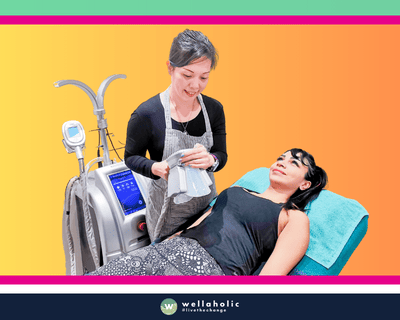
Expanding Services Among Current Patients
Many cryolipolysis candidates are new to aesthetic practices but often become lifetime patients who request other procedures, both surgical and nonsurgical. In the experience of one of the authors (R.S.), the majority of patients seeking cryolipolysis are new to his practice. However, 75% of his patients who receive nonsurgical procedures request at least 1 more procedure thereafter. Similarly, a 2007 joint survey by the ASPS and the ASAPS found that 31% of plastic surgeons reported that at least 26% of their patients undergoing noninvasive aesthetic procedures were subsequently likely to have surgery.12 Conversely, current liposuction patients may also become interested in cryolipolysis. One author (R.S.) reported that many of his patients who have undergone liposuction select cryolipolysis for future body contouring. Another author (J.F.) also has experience with this concept, illustrated by a patient who began her treatment with abdominoplasty and a mini facelift after drastic weight loss. She later chose cryolipolysis to improve the contour of her upper arms (Figure 4), inner thighs, and gluteal fold.
In 2013, Stevens et al16 reported experience with cryolipolysis in their practice based on a retrospective chart review of 528 consecutive patients treated between 2010 and 2012. Of the 66% of cryolipolysis patients who were new to the practice, 62% had not previously undergone any cosmetic procedures (89% had not previously undergone liposuction).16 Forty percent of these new patients who came to the practice for cryolipolysis became established patients within the practice and later underwent additional surgical or nonsurgical procedures.16
During a patient consultation, the authors suggest that 1 staff member may review the cryolipolysis procedure, while another consults on other aesthetic offerings suitable for the patient. In the authors’ experience, it is common to combine certain procedures during cryolipolysis sessions (eg, administering facial injectables while performing cryolipolysis).
Conclusion
Patients are highly interested in current and emerging noninvasive aesthetic treatment options, such as cryolipolysis. Thus, aesthetic plastic surgeons are increasingly incorporating these nonsurgical procedures into their practices in an effort to meet this demand and remain competitive. Cryolipolysis is a safe and effective option for nonobese individuals who want to target fat bulges in specific body areas and achieve a more contoured appearance.
Source
- Journal of Cosmetic Dermatology, 12, p149 to 152
- Longitudinal evaluation of cryolipolysis efficacy: two case studies
- Eric F Bernstein, MD, MSE

Serene Chiam, Aesthetic Director
Serene Chiam is the Aesthetic Director at Wellaholic, a well-known aesthetic chain in Singapore. She has more than ten years of experience in the aesthetics industry. With a Bachelor of Health Science (Aesthetics) and CIDESCO certifications, she expertly combines scientific knowledge with practical skills. Serene is known for her personalized approach to beauty, ensuring each Wellaholic client’s journey is unique and transformative. Her significant contributions have been pivotal in establishing Wellaholic’s reputation for excellence in aesthetic wellness.
Contact Serene at support@wellaholic.com
GET IN TOUCH
Book Now Pay Later

WellaFreeze™ 360 Advanced Fat Freezing
- ⭐ Latest 4th Generation Freezing. WellaFreeze™ 360 advanced fat freezing uses the latest fat freeze technology for the highest fat reduction per session.
- ⭐ Up to 34% Fat Loss Each Session. Increase in percentage of fat loss due to newer technology and coverage.
- ⭐ 360° Surround Cooling Technology. The handles or cooling cups can be adjusted to fit all body curves and contouring for best freezing.
- ⭐ Breathing Technology Reduces Bruising. “Breathing” technology improves freeze while minimising bruising from the suction.
- ⭐ Shorter Time Needed. Each duration is reduced from typical 60 minutes to just 30 minutes.
- ⭐ Award-Winning. Wellaholic’s treatments have been recognized by top beauty publications such as Daily Vanity, Beauty Insider, and Tropika Club Magazine.
- ⭐ Over 2000 Verified Customer Reviews. Wellaholic has over 2000 positive reviews from customers, and >50% are repeat customers.
